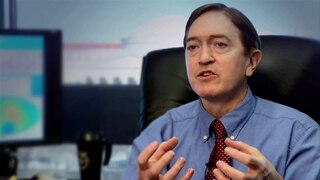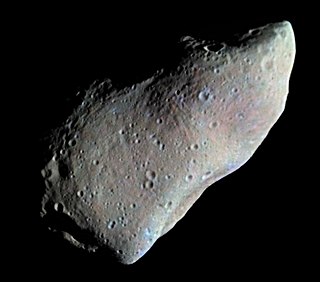Related Research Articles

The Moon is Earth's only natural satellite. It orbits at an average distance of 384,400 km (238,900 mi), about 30 times the diameter of Earth. Over time Earth's gravity has caused tidal locking, causing the same side of the Moon to always face Earth. Because of this, the lunar day and the lunar month are the same length, at 29.5 Earth days. The Moon's gravitational pull – and to a lesser extent, the Sun's – are the main drivers of Earth's tides.

Callisto, or Jupiter IV, is the second-largest moon of Jupiter, after Ganymede. In the Solar System it is the third-largest moon after Ganymede and Saturn's largest moon Titan, and as large as the smallest planet Mercury, though only about a third as massive. Callisto is, with a diameter of 4,821 km, roughly a third larger than Earth's Moon and orbits Jupiter on average at a distance of 1,883,000 km, which is about six times further out than the Moon orbiting Earth. It is the outermost of the four large Galilean moons of Jupiter, which were discovered in 1610 with one of the first telescopes, being visible from Earth with common binoculars.

Ida, minor planet designation 243 Ida, is an asteroid in the Koronis family of the asteroid belt. It was discovered on 29 September 1884 by Austrian astronomer Johann Palisa at Vienna Observatory and named after a nymph from Greek mythology. Later telescopic observations categorized Ida as an S-type asteroid, the most numerous type in the inner asteroid belt. On 28 August 1993, Ida was visited by the uncrewed Galileo spacecraft while en route to Jupiter. It was the second asteroid visited by a spacecraft and the first found to have a natural satellite.

Phobos is the innermost and larger of the two natural satellites of Mars, the other being Deimos. The two moons were discovered in 1877 by American astronomer Asaph Hall. It is named after Phobos, the Greek god of fear and panic, who is the son of Ares (Mars) and twin brother of Deimos.

Ina is a peculiar small depression on the Moon, in Lacus Felicitatis. It is D-shaped, 2.9 km × 1.9 km wide and 64 m deep.

The geology of the Moon is quite different from that of Earth. The Moon lacks a true atmosphere, and the absence of free oxygen and water eliminates erosion due to weather. Instead, the surface is eroded much more slowly through the bombardment of the lunar surface by micrometeorites. It does not have any known form of plate tectonics, it has a lower gravity, and because of its small size, it cooled faster. In addition to impacts, the geomorphology of the lunar surface has been shaped by volcanism, which is now thought to have ended less than 50 million years ago. The Moon is a differentiated body, with a crust, mantle, and core.

Space weathering is the type of weathering that occurs to any object exposed to the harsh environment of outer space. Bodies without atmospheres take on many weathering processes:

Lunar soil is the fine fraction of lunar regolith found on the surface of the Moon and contributes to the Moon's tenuous atmosphere. Lunar soil differs in its origin and properties significantly from terrestrial soil.

Crater counting is a method for estimating the age of a planet's surface based upon the assumptions that when a piece of planetary surface is new, then it has no impact craters; impact craters accumulate after that at a rate that is assumed known. Consequently, counting how many craters of various sizes there are in a given area allows determining how long they have accumulated and, consequently, how long ago the surface has formed. The method has been calibrated using the ages obtained by radiometric dating of samples returned from the Moon by the Luna and Apollo missions. It has been used to estimate the age of areas on Mars and other planets that were covered by lava flows, on the Moon of areas covered by giant mares, and how long ago areas on the icy moons of Jupiter and Saturn flooded with new ice.

Secondary craters are impact craters formed by the ejecta that was thrown out of a larger crater. They sometimes form radial crater chains. In addition, secondary craters are often seen as clusters or rays surrounding primary craters. The study of secondary craters exploded around the mid-twentieth century when researchers studying surface craters to predict the age of planetary bodies realized that secondary craters contaminated the crater statistics of a body's crater count.

951 Gaspra is an S-type asteroid that orbits very close to the inner edge of the asteroid belt. Gaspra was discovered by Russian astronomer G. N. Neujmin in 1916. Neujmin named it after Gaspra, a Black Sea retreat that was visited by his contemporaries, such as Gorky and Tolstoy.

The Mars ocean theory states that nearly a third of the surface of Mars was covered by an ocean of liquid water early in the planet's geologic history. This primordial ocean, dubbed Paleo-Ocean or Oceanus Borealis, would have filled the basin Vastitas Borealis in the northern hemisphere, a region that lies 4–5 km below the mean planetary elevation, at a time period of approximately 4.1–3.8 billion years ago. Evidence for this ocean includes geographic features resembling ancient shorelines, and the chemical properties of the Martian soil and atmosphere. Early Mars would have required a denser atmosphere and warmer climate to allow liquid water to remain at the surface.

Lunar swirls are enigmatic features found across the Moon's surface, which are characterized by having a high albedo, appearing optically immature, and (often) having a sinuous shape. Their curvilinear shape is often accentuated by low albedo regions that wind between the bright swirls. They appear to overlay the lunar surface, superposed on craters and ejecta deposits, but impart no observable topography. Swirls have been identified on the lunar maria and on highlands - they are not associated with a specific lithologic composition. Swirls on the maria are characterized by strong albedo contrasts and complex, sinuous morphology, whereas those on highland terrain appear less prominent and exhibit simpler shapes, such as single loops or diffuse bright spots.

A planetary surface is where the solid or liquid material of certain types of astronomical objects contacts the atmosphere or outer space. Planetary surfaces are found on solid objects of planetary mass, including terrestrial planets, dwarf planets, natural satellites, planetesimals and many other small Solar System bodies (SSSBs). The study of planetary surfaces is a field of planetary geology known as surface geology, but also a focus on a number of fields including planetary cartography, topography, geomorphology, atmospheric sciences, and astronomy. Land is the term given to non-liquid planetary surfaces. The term landing is used to describe the collision of an object with a planetary surface and is usually at a velocity in which the object can remain intact and remain attached.

Planetary science is the scientific study of planets, celestial bodies and planetary systems and the processes of their formation. It studies objects ranging in size from micrometeoroids to gas giants, aiming to determine their composition, dynamics, formation, interrelations and history. It is a strongly interdisciplinary field, which originally grew from astronomy and Earth science, and now incorporates many disciplines, including planetary geology, cosmochemistry, atmospheric science, physics, oceanography, hydrology, theoretical planetary science, glaciology, and exoplanetology. Allied disciplines include space physics, when concerned with the effects of the Sun on the bodies of the Solar System, and astrobiology.

A permanently shadowed crater is a depression on a body in the Solar System within which lies a point that is always in darkness.
Comparative planetary science or comparative planetology is a branch of space science and planetary science in which different natural processes and systems are studied by their effects and phenomena on and between multiple bodies. The planetary processes in question include geology, hydrology, atmospheric physics, and interactions such as impact cratering, space weathering, and magnetospheric physics in the solar wind, and possibly biology, via astrobiology.
Astropedology is the study of very ancient paleosols and meteorites relevant to the origin of life and different planetary soil systems. It is a branch of soil science (pedology) concerned with soils of the distant geologic past and of other planetary bodies to understand our place in the universe. A geologic definition of soil is “a material at the surface of a planetary body modified in place by physical, chemical or biological processes”. Soils are sometimes defined by biological activity but can also be defined as planetary surfaces altered in place by biologic, chemical, or physical processes. By this definition, the question for Martian soils and paleosols becomes, were they alive? Astropedology symposia are a new focus for scientific meetings on soil science. Advancements in understanding the chemical and physical mechanisms of pedogenesis on other planetary bodies in part led the Soil Science Society of America (SSSA) in 2017 to update the definition of soil to: "The layer(s) of generally loose mineral and/or organic material that are affected by physical, chemical, and/or biological processes at or near the planetary surface and usually hold liquids, gases, and biota and support plants". Despite our meager understanding of extraterrestrial soils, their diversity may raise the question of how we might classify them, or formally compare them with our Earth-based soils. One option is to simply use our present soil classification schemes, in which case many extraterrestrial soils would be Entisols in the United States Soil Taxonomy (ST) or Regosols in the World Reference Base for Soil Resources (WRB). However, applying an Earth-based system to such dissimilar settings is debatable. Another option is to distinguish the (largely) biotic Earth from the abiotic Solar System, and include all non-Earth soils in a new Order or Reference Group, which might be tentatively called Astrosols.

The Moon bears substantial natural resources which could be exploited in the future. Potential lunar resources may encompass processable materials such as volatiles and minerals, along with geologic structures such as lava tubes that, together, might enable lunar habitation. The use of resources on the Moon may provide a means of reducing the cost and risk of lunar exploration and beyond.

Louth is an impact crater on Mars located at 70.19°N 103.24°E in the Mare Boreum quadrangle. Located within Vastitas Borealis, the crater has a diameter of 36.29 kilometres and is named after Louth, a town in Ireland.
References
- ↑ Cole, George H. A.; Woolfson, Michael Mark (2002). Planetary Science: The Science of Planets Around Stars. CRC Press. p. 96. ISBN 9780750308151.
- ↑ Speyerer, Emerson J.; Povilaitis, Reinhold Z.; Robinson, Mark S.; Thomas, Peter C.; Wagner, Robert V. (13 October 2016). "Quantifying crater production and regolith overturn on the Moon with temporal imaging". Nature. 538 (7624): 215–218. Bibcode:2016Natur.538..215S. doi:10.1038/nature19829. PMID 27734864. S2CID 4443574.